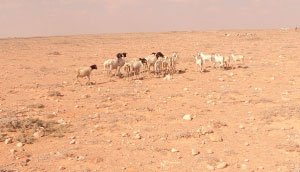Outcome of Jilaal Dry Season (Jan – Mar)
Issued: April 19, 2011
 The food security situation in Somalia remains as classified during the post Deyr 2010/11 assessment (Jan – Jun 2011) with an estimated 2.4 million people in crisis. However, the effects of the ongoing drought, deteriorating purchasing power, rampant conflict and limited humanitarian space continue to aggravate the situation in most parts of the country. The Jilaal dry season has been particularly harsh, considering the prevalence of dry conditions for almost 9 months, as short the rainy season failed in 2010 due to La-Nina effect. The outcome of the dry season is evident in severe water crisis with extremely high prices of water, depleted pasture, deteriorated livestock condition, increased cases of livestock deaths, displacements and increased destitution in central regions. In addition, the rising trend in cereal prices triggered by the drought inducedshortfall in Deyr 2010 cereal production sustained in the first quarter of 2011, affecting both urban and poor populations. Although off-season maize harvest was collected in Juba regions in March 2011, the supply was not sufficient to stabilize high maize prices. Current Gu planting activities are below average due to the high costs of cultivation and uncertainty of the Gu season performance. The recent rapid nutrition assessments in Juba regions indicate significant deterioration of the nutrition situation in agropastoral and pastoral livelihoods, while slight improvement is observed in Juba riverine, mostly attributable to off-season crop production and health interventions.
The food security situation in Somalia remains as classified during the post Deyr 2010/11 assessment (Jan – Jun 2011) with an estimated 2.4 million people in crisis. However, the effects of the ongoing drought, deteriorating purchasing power, rampant conflict and limited humanitarian space continue to aggravate the situation in most parts of the country. The Jilaal dry season has been particularly harsh, considering the prevalence of dry conditions for almost 9 months, as short the rainy season failed in 2010 due to La-Nina effect. The outcome of the dry season is evident in severe water crisis with extremely high prices of water, depleted pasture, deteriorated livestock condition, increased cases of livestock deaths, displacements and increased destitution in central regions. In addition, the rising trend in cereal prices triggered by the drought inducedshortfall in Deyr 2010 cereal production sustained in the first quarter of 2011, affecting both urban and poor populations. Although off-season maize harvest was collected in Juba regions in March 2011, the supply was not sufficient to stabilize high maize prices. Current Gu planting activities are below average due to the high costs of cultivation and uncertainty of the Gu season performance. The recent rapid nutrition assessments in Juba regions indicate significant deterioration of the nutrition situation in agropastoral and pastoral livelihoods, while slight improvement is observed in Juba riverine, mostly attributable to off-season crop production and health interventions.
Dry weather conditions persist
The country remained largely dry throughout the Jilaal season severely impacting vegetation and water resources, which are significantly degraded in key pastoral areas of the country. Severe water crisis persists and prices of water are extremely high. As a result, livestock is considerably emaciated and increased cases of abortion and death, particularly off-springs and lactating animals, are reported. The situation is worst in the livelihoods of Coastal Deeh (Central and Bari regions), Cowpea Belt (Central), Southern Inland Pastoral (Hiran), Nugal Valley and Sool Plateau (North). Drought displaced tens of thousands of people in the first quarter of 2011. For instance, nearly 6,000 people were displaced in Hiran region, while about 4,000 rural poor people became destitute in Coastal Deeh and Cowpea Belt.
Upward trend of food prices
As cereal stocks continue declining in crop-producing regions of the South, local cereal prices picked-up in most areas, reaching 40-45 percent increment in some markets in the last three months. The highest annual price increase, equivalent to 135 percent is recorded in Bay, while the lowest of 20 percent is in Northeast. The price decline in the reporting period was only observed in the regions of Northwest due to high supply from the previous good Karan season. Additionally, imported commodity prices remain high compared to a year ago, particularly in the Somali Shilling (SoSh) zones of the country. High food prices continue to negatively affect purchasing power of both urban and rural people. Significant decline in the amount of cereals that could be purchased through daily labour wages or local quality goat sales is deserved in most areas of the country. The cereal prices are expected to increase in the coming months, which will lead to further deterioration of the purchasing power of Somali people.

















